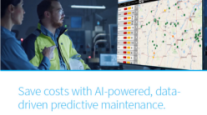Special to Transport Topics
Parsing Data to Better Understand Risk

[Stay on top of transportation news: Get TTNews in your inbox.]
Dozens of data sets go into using predictive analytics to determine a truck driver’s risk of being in an accident. Similarly, there are dozens of different interventions that fleets can stage to engage with at-risk drivers before safety infractions occur.
“We can make decisions about whether or not coaching and development has been impactful or if there are other steps that need to be taken to eliminate risk,” said Tim Smith, senior vice president at Hub Group. “It is all about how we engage that driver first, before those behaviors lead to accidents or injuries.”
The goal for technology vendors and fleets is to prevent cost- and labor-intensive safety infractions and their consequences, including driver citations, suspensions and terminations.
Analytics companies strive to provide insights that are as complete as possible to help managers choose the most effective driver engagement. They identify at-risk drivers and elaborate on each driver’s high-risk behaviors.
Host Seth Clevenger went to CES 2020 to look at the road ahead for electric-powered commercial vehicles. He spoke with Scott Newhouse of Peterbilt and Chris Nordh of Ryder System. Hear a snippet, above, and get the full program by going to RoadSigns.TTNews.com.
“That piece, for us, is really important,” said Hayden Cardiff, founder and CEO of Idelic. “We could have the most accurate predictive analytics known to man, but if we don’t give our customers a way to actually do something about it, it doesn’t help them.”
Predictive analytics systems provide concrete information that managers can show drivers during a pre-emptive engagement. Fleets that incorporate in-cab video into their analytics systems can show drivers clips of their own risky behavior and suggest improvements, said Chris Orban, vice president of data science for Trimble Transportation.
Simply talking to an at-risk driver is a common first step, but drivers might need additional coaching such as watching safety videos, attending ride-alongs or participating in skills-building sessions.
“For us, it’s all about educating … and retaining [the drivers] you have,” said Ron Faherty, president of ARL Network.
Predictive analytics systems can bring managers’ attention to trends across an entire fleet or a specific region where additional training may be necessary. ARL Network’s field safety compliance managers use the system data to home in on larger themes and create agendas for specific safety meetings, Faherty said.
“If they see a certain amount of egregious accidents happening in Chicago and it’s different in Newark, those regions’ safety meetings are going to be themed completely differently based on the data,” he said.

Read more iTECH stories
Although risk assessment technology often is associated with identifying negative performance, the converse also is true: Managers easily can assess which drivers are the safest and reward them.
“You can’t just be dealing with the problematic people. It’s also about recognizing the people that are being good ambassadors of the road,” Faherty said. “We’re creating and putting programs in place to reward the people whose names you don’t hear [in a negative way] every day.”
Driver rewards can take a variety of forms, including public recognition, gift cards, extra time off and monetary bonuses.
Fleets also can use analytics system rankings to directly involve drivers in their own performance scores.
“[Some] have taken a gamification approach, where … you get in the spirit of competition and want to score the highest in terms of your performance against competitors,” said Ashim Bose, Omnitracs’ chief data scientist and vice president of artificial intelligence, machine learning and data.
Technology developers are working on system advancements such as automatically recommending specific coaching sessions that would be effective in different high-risk situations.
“Being able to have that training recommendation engine is something that our data science team is working on right now and something we’re really excited about,” Idelic’s Cardiff said.
The same solution-finding concept could be applied in situations where drivers are flagged as at risk of leaving a company.
“Although we do a good job of predicting which drivers are likely to churn, we also want to give the customer some direction on what to do,” Orban said.
Some predictive analytics systems currently pinpoint drivers with a high departure risk, but it’s then up to managers to assess driver dissatisfaction and devise solutions. Managers might uncover dissatisfaction factors including the number of hours on the road, inadequate assignment notification time, repeatedly ignoring driver route requests or family issues that affect work schedules.
“All these things together represent how we treat our drivers and work with them as human beings, not just as people moving a truck,” Orban said.
Want more news? Listen to today's daily briefing:





